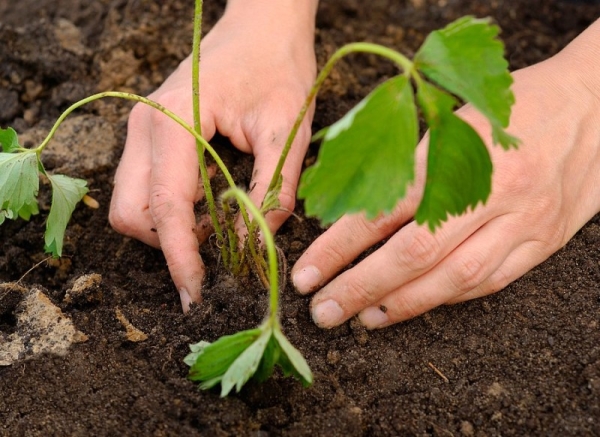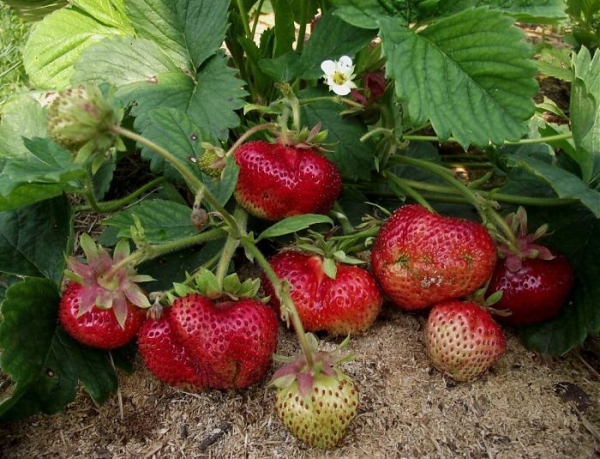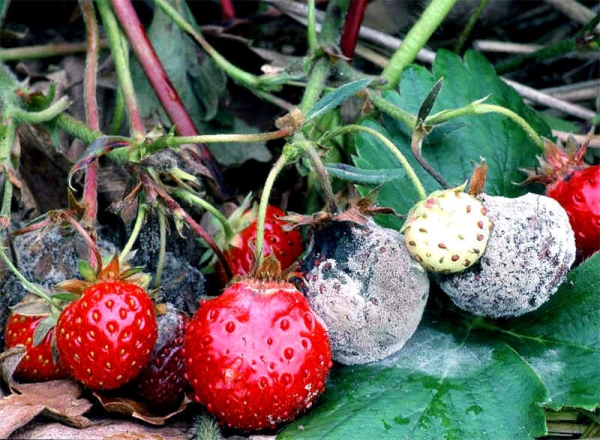Many of us love strawberries. Especially if the berries are juicy, sweet and large. All these virtues include Gigantella variety.
Strawberry Gigantella is quite a popular variety. Many gardeners are interested in it, since it is she who stands out for berries of large sizes and high yields.
This variety requires very careful care., because it is very capricious of any changes. With the wrong care, the bushes can dry out or the berries will be small.
Table of contents
Characteristics and description of the variety
Strawberry garden Gigantella was bred by breeders in the Netherlands. The name was due to its huge size.
The variety is mid-season, mostly harvested in early July.
Pulp of saturated color, dense, juicy, taste is sweet. The appearance of scarlet. Due to its density, strawberries well transportedwithout changing their appearance and taste.
Features strawberry Gigantella
According to the description bush can reach a height of 60 cmthat is important to consider when planting plants, planting away from each other. The leaf is quite large.
Loves sunny places. Berries can be subjected to freezing, taste in this case does not change. Harvesting reaches three kilograms.
Strawberry bushes grow pretty quickly. It is necessary to remove all whiskers in the process of leaving.. The taste of strawberries is sweet with a slight sourness and pineapple aroma.
The advantage of this species is in its frost resistance, but it should be noted that in the winter to cover the bushes still have, as the plant is quite capricious.

Advantages and disadvantages
Advantages, of course, Gigantella a large number, but there are some minor drawbacks. These include frequent watering bushes.
Attention is paid to the fact that the strawberries do not overflow, water gently, water in moderation, but often.
In the spring, approximately at the beginning of May, flowers form on the bushes. It ripens in early June. It means that berries appear rapidlyafter flowering has passed.
The first berries are about 10 cm in size, of a flat surface, about 80-100 grams in weight.
Landing rules
Bushes are planted on the ground, where the sun's rays fall, from the south-west side. The place should not be too wet and be located in the valley.
Soil preparation does not require special measures and includes loosening, leveling and fertilizer. Seedlings are added in September and at the end of April - 2 times per year. Seedlings can be purchased from experienced gardeners or grow yourself.
Planting seeds strawberry varieties Gigantella:
Favorable environmental conditions are created: temperature conditions (20-25 degrees), soil moisture, good illumination (for this you can use special lamps).
After the seeds are sown, after 3 weeks, the first shoots appear. Seedlings dive for the development of a good root system at a distance of 7 cm from each other.
The seedling before planting should have 5 leaves and strong roots.which are cut to 6 cm. Further, seedlings are dropping at a distance of 20 cm from each other, while the distance between rows should be at least 70 cm.

It is better to plant in cloudy times, otherwise in sunny weather, the possibility that the plants will not be great. Immediately you need to arrange watering, about 0.5 liters per sapling.
After two weeks, the seedlings are checked, those that are not taken, are removed and new ones are added in their place.
Planting strawberries (strawberries) variety Gigantella:
Care and reproduction
Caring for this type of strawberry is no different from caring for other varieties. But there are subtleties of caring for Gigantella.
Only in the event that you want to multiply it, you can leave a few bushes, from which whiskers are added.
This type is reproduced by carpetthat is, the whiskers are not removed, grow and root. After this reproduction stops and fruiting begins.
Strawberry Gigantella requires some care. After the snow melts, the plants inspect and process, remove the dry leaves, process the pesticides.
Further soil is fertilized with onion peel. It must be expanded in rows between the bushes. Over time, when the strawberries begin to grow, fertilizers are applied there.
Dry leaves are removed before the flowers appear. Next, feed up. They put straw and needles near the bushes, which will retain moisture for the appearance of good fruits in the future and protects against various diseases.

This variety is ruined by many pests.. Therefore, special anti-insect products are chosen for care. Spraying done five times per season. In early May, a solution is made from "Fitosporin" and "Gumi".
If you carefully approach the issue of processing, you can significantly reduce the level of infection of planted plants. Plants can be transplanted to another land plot, but only after 8 years.
Compost is a good fertilizer.. It is enclosed under each bush about one bucket. It nourishes the soil well and promotes the rapid growth of strawberries.
At that moment, when buds begin to form on the bushes, the plant needs potassium, so potassium salt is applied as fertilizer.
With accuracy it can be noted that Gigantella strawberry is a wonderful addition to your garden. Having planted this variety, you will be satisfied with the harvest and will expand the area of the land plot for planting new bushes.
Diseases and pests
Common diseases of strawberry include:
- Brown spot. On the edges of the leaves appear burned and dark protuberances appear. Treatment: in the spring it is necessary to spray the bushes with phytosporin or Bordeaux one percent mixture. Carry out these procedures before the appearance of buds.
- Septoria or white spot. White spots with a dark red border appear in the center of the leaf.
- Gray rot. Manifested on the fruit in the form of dark spots, covered with a gun.
- Black rot. Arises on the leaves.Treatment: treatment in the spring Bordeaux liquid.
- Phytosporous wilting. Folding leaves turned gray.
- Fusarium wilt. Irregularities appear on the edges of the leaflet, then the entire leaf is deformed.
- Verticillary wilting. Wilting old and young leaves on the bushes.
To prevent these diseases from appearingbefore planting, the root system is placed in a solution of one liter of water and seven grams of agate 23k. If the disease is attacked, then it is necessary to treat with metaxyl.

Strawberry pests:
- Beetles. It is necessary to cultivate the land around the plant with karbofos, water it with a decoction of onion peel.
- Birds. They are scared away by setting around the perimeter of the plot where strawberries are planted, twigs a little over a meter high. It is necessary to throw a grid on them, or hang something shiny on each peg, for example a tinsel.
- Slugs. To combat them use beer. It is poured into flat containers and placed under the bushes. In the morning you need to collect slugs.
- Pliers. So that they do not attack the strawberries,In early spring, the bushes are treated with phosphamide or hot solution of potassium permanganate.
- Weevils. Treat the shrub with an actellic two weeks before flowering.
- Ants. To combat them use bait, which are filled with poison.
Gardeners reviews
“The berries of strawberry Gigantella are tasty and fragrant. Plus its that she demands a minimum of efforts in leaving. It is easy to weed, because the bushes are high, the harvest is convenient, because the berries are large. ”
“I purchased the strawberry seedlings of the Gigantella variety back in 1991. This type of plant was not as well known to many gardeners. The bush shocked me because it was very powerful. Harvesting huge fruits of my delight knew no bounds. But soon after five years, I was forced to abandon this variety. The berries have become much smaller and the taste has changed. ”
“I read reviews about strawberries Gigantella on the Internet for a long time and I wanted to buy material for planting. It was difficult to find the seeds. I wrote them through the online store. After receiving the seeds, planted them immediately (in February). All the seeds sprung up and pretty quickly. Drove planting material in the garden, processed as expected.In the summer I received a decent harvest of very tasty, sweet, big strawberries. ”
“For several years in a row, the strawberry variety“ Gigantella ”pleases us with its harvest. Berries of medium size, sweet. Our soil is poor in minerals, so fertilizer often has to be applied. ”
Thus, it is necessary to conclude that this variety takes pride of place on any plot of land. Having planted Gigantella strawberries, you will be satisfied with the collection of its berries and will multiply this variety with pleasure.
